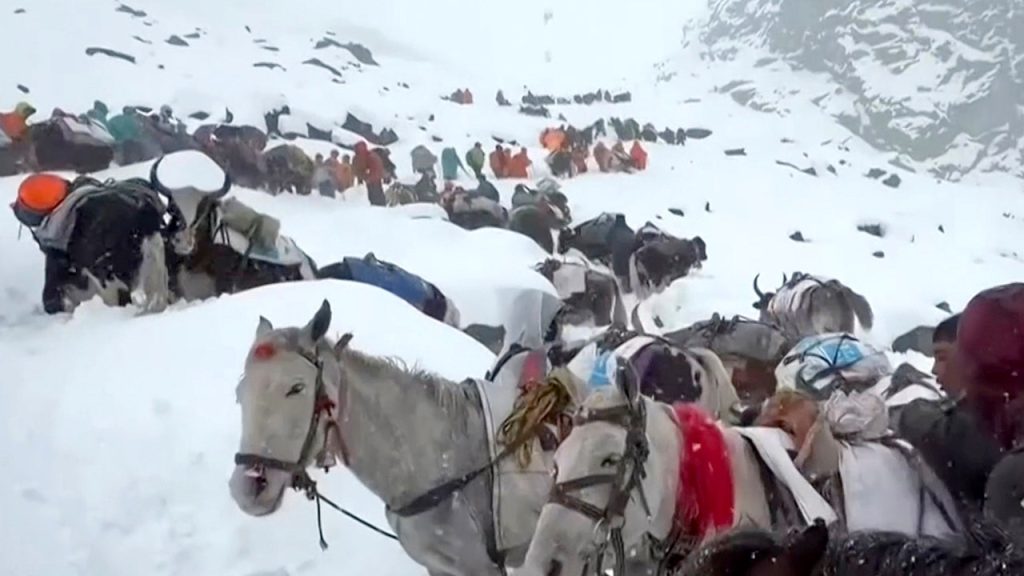Listen to the article
A deadly avalanche swept through a mountain camp in Nepal on Monday, claiming the lives of five foreign climbers and two Nepali guides at Mount Yalung Ri’s base camp, officials confirmed. Five additional foreign climbers sustained injuries in the disaster that struck at an elevation of 16,070 feet.
Authorities have not yet disclosed the nationalities or identities of the victims and injured climbers as rescue operations continue. The remote location and challenging weather conditions have complicated rescue efforts significantly.
A U.S. State Department spokesperson acknowledged awareness of the incident, stating they are monitoring the situation closely. “The U.S. Department of State has no higher priority than the safety and security of U.S. citizens,” the spokesperson said. “We are closely monitoring the situation and stand ready to provide consular assistance.”
Rescue crews attempting to reach the disaster site have faced significant obstacles. An initial helicopter rescue mission was forced to turn back due to deteriorating weather conditions, according to Nepal’s Armed Police Force spokesperson Shailendra Thapa. Rescuers planned to make another attempt at dawn on Tuesday, while ground teams continued to approach the site on foot.
Mount Yalung Ri, which stands at 18,370 feet, is generally considered appropriate for novice mountaineers without extensive high-altitude climbing experience. The peak is one of Nepal’s many popular climbing destinations that attract thousands of adventure tourists annually.
This tragic incident highlights the inherent risks of mountain expeditions in the Himalayas, even on peaks considered less challenging than giants like Everest. Nepal’s mountaineering industry has seen increasing safety concerns as climbing tourism continues to grow throughout the region.
Nepal, home to eight of the world’s 14 tallest mountains including Mount Everest, has a robust mountain tourism economy that brings vital revenue to the country but also faces recurring safety challenges. The Himalayan nation has experienced several climbing disasters in recent years, raising questions about safety protocols and weather monitoring systems.
This avalanche follows another recent tragedy in the region. Earlier this month, a South Korean climber perished after being caught in a powerful storm while attempting to summit another Himalayan peak located just south of Mount Everest.
Autumn is a popular climbing season in Nepal, as many climbers tackle smaller peaks before the onset of winter weather makes mountaineering even more dangerous. The period between monsoon season and winter offers relatively stable conditions that attract climbers from around the world.
Mountain safety experts have long emphasized the unpredictable nature of high-altitude weather and avalanche risks in the Himalayas. Even experienced climbers and well-prepared expeditions can face sudden dangers when conditions change rapidly at high elevations.
Local authorities and climbing organizations will likely review safety protocols following this incident, as Nepal’s tourism industry balances promoting adventure tourism with ensuring climber safety. The mountaineering community continues to advocate for improved weather forecasting, emergency response capabilities, and avalanche prevention measures throughout the Himalayan region.
As rescue operations continue at Mount Yalung Ri, the climbing community worldwide awaits further details about the victims and circumstances surrounding this devastating avalanche.
Fact Checker
Verify the accuracy of this article using The Disinformation Commission analysis and real-time sources.




10 Comments
This is a sobering reminder of the dangers inherent in high-altitude mountaineering. My condolences go out to the families and loved ones of those who perished. I hope the injured climbers make a full recovery.
You’re right, this is a tragic loss of life. I’m glad the authorities are working to provide assistance and support to the affected individuals and their communities during this difficult time.
My heart sinks reading about this devastating avalanche. Mountaineering expeditions require immense skill, preparation and risk mitigation, yet nature’s power can still be unpredictable and unforgiving. I hope the rescue efforts are successful and that the causes of this tragedy can be thoroughly investigated.
You raise a good point. Thoroughly understanding the factors that led to this avalanche could help inform future safety protocols and potentially prevent similar incidents. The investigation will be important for honoring those lost and improving mountaineering safety going forward.
This is a tragic incident. My heart goes out to the families and loved ones of those who lost their lives. Mountaineering can be incredibly dangerous, and my hope is that the rescue efforts are successful in recovering all those affected.
You’re right, the remote and harsh conditions make rescue efforts extremely challenging. I appreciate the authorities’ ongoing efforts to assist the victims and their families during this difficult time.
It’s commendable that the U.S. State Department is monitoring the situation and stands ready to provide consular assistance. International cooperation and support can be crucial in the aftermath of such disasters.
I’m curious to know more about the specific circumstances that led to this avalanche. Were there any warning signs or weather conditions that may have contributed to the disaster? Understanding the causes could help inform future risk assessment and prevention efforts.
Avalanches can be unpredictable and devastating, especially at high altitudes. It’s important that climbers are prepared and take proper safety precautions, but sometimes even the best planning isn’t enough to prevent such tragedies. My condolences to all those impacted.
Agreed. Mountaineering requires immense skill and experience, and even then the risks can never be fully eliminated. Hopefully lessons can be learned from this incident to improve safety protocols for future expeditions.